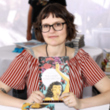BTTM FDRS
(Graphic Novel)
GRAPH DANIE
1 available
Copies
| Location | Call Number | Status |
|---|---|---|
| Westover - Adult Graphic Novel | GRAPH DANIE | Available |
Description
More Details
Notes
Subjects
Fashion designers -- Comic books, strips, etc.
Gentrification -- Comic books, strips, etc.
Graphic novels
Graphic novels.
Horror comic books, strips, etc.
Horror comics.
Monsters -- Comic books, strips, etc.
Racism -- Comic books, strips, etc.
Social classes -- Comic books, strips, etc.
Also in this Series
Published Reviews
Publisher's Weekly Review
This sharply observed satire stars a monstrous physical manifestation born of the evils of racism, gentrification, and cultural appropriation. When Darla, an unemployed African-American art school student, moves into a windowless former factory in the Bottomyards, a notoriously dangerous section of Chicago's South Side, she begins to see and hear disquieting things. Her upper-class white pal, Cynthia, and Hadley, a fashion director, are initially afraid to visit ("That part of town is like a war-zone!") but yet are attracted by the area's "authenticity," for which Darla calls Cynthia out: "You're trying to use me and my scary black neighborhood to look cool." Meanwhile, the terror lurking within Bottomyards's secret passages has awakened, and an atmosphere of subtle menace builds into full-out chaos and body horror. Daniels (Upgrade Soul) manages to locate the humanity in even his least sympathetic characters while peppering the narrative with well-honed jabs at art school jargon and the frequent racial biases of mass media (exemplified here by the local media framing the breaking story as Cynthia's rather than Darla's). Passmore (Your Black Friend), a skilled visual stylist with a particularly fine, bright palette, ably renders the humor in the horror and the horror in the humor (the story's title has a nasty double meaning). The book pokes fun at the zeitgeist with a sharp stick in a manner reminiscent of Jordan Peele's film Get Out. (June) © Copyright PWxyz, LLC. All rights reserved.
Library Journal Review
Escaping her upwardly mobile parents, Darla moves back to their old neighborhood in Chicago's Bottomyards to find bare-bones housing where she can grow her design business on the cheap. Paradoxically, the area's "authentic" ambiance has begun attracting the trendy-chic media and business interests. But her huge, windowless building hides a secret legacy from a biotech invention twisted by would-be exploiters. A savage Afrofuturistic horror comedy about gentrification, racial invisibility, and cultural appropriation in knock-your-eyes-out, "non-literal" coloring. (SLJ 6/14/19)
Library Journal Reviews
Escaping her upwardly mobile parents, Darla moves back to their old neighborhood in Chicago's Bottomyards to find bare-bones housing where she can grow her design business on the cheap. Paradoxically, the area's "authentic" ambiance has begun attracting the trendy-chic media and business interests. But her huge, windowless building hides a secret legacy from a biotech invention twisted by would-be exploiters. A savage Afrofuturistic horror comedy about gentrification, racial invisibility, and cultural appropriation in knock-your-eyes-out, "non-literal" coloring. (SLJ 6/14/19)
Copyright 2019 Library Journal.Publishers Weekly Reviews
This sharply observed satire stars a monstrous physical manifestation born of the evils of racism, gentrification, and cultural appropriation. When Darla, an unemployed African-American art school student, moves into a windowless former factory in the Bottomyards, a notoriously dangerous section of Chicago's South Side, she begins to see and hear disquieting things. Her upper-class white pal, Cynthia, and Hadley, a fashion director, are initially afraid to visit ("That part of town is like a war-zone!") but yet are attracted by the area's "authenticity," for which Darla calls Cynthia out: "You're trying to use me and my scary black neighborhood to look cool." Meanwhile, the terror lurking within Bottomyards's secret passages has awakened, and an atmosphere of subtle menace builds into full-out chaos and body horror. Daniels (Upgrade Soul) manages to locate the humanity in even his least sympathetic characters while peppering the narrative with well-honed jabs at art school jargon and the frequent racial biases of mass media (exemplified here by the local media framing the breaking story as Cynthia's rather than Darla's). Passmore (Your Black Friend), a skilled visual stylist with a particularly fine, bright palette, ably renders the humor in the horror and the horror in the humor (the story's title has a nasty double meaning). The book pokes fun at the zeitgeist with a sharp stick in a manner reminiscent of Jordan Peele's film Get Out. (June)
Copyright 2019 Publishers Weekly.Reviews from GoodReads
Citations
Daniels, E. C., & Passmore, B. (2019). BTTM FDRS ([Fantagraphics edition].). Fantagraphics Books.
Chicago / Turabian - Author Date Citation, 17th Edition (style guide)Daniels, Ezra Claytan and Ben, Passmore. 2019. BTTM FDRS. Seattle, Washington: Fantagraphics Books.
Chicago / Turabian - Humanities (Notes and Bibliography) Citation, 17th Edition (style guide)Daniels, Ezra Claytan and Ben, Passmore. BTTM FDRS Seattle, Washington: Fantagraphics Books, 2019.
Harvard Citation (style guide)Daniels, E. C. and Passmore, B. (2019). BTTM FDRS. [Fantagraphics edn]. Seattle, Washington: Fantagraphics Books.
MLA Citation, 9th Edition (style guide)Daniels, Ezra Claytan,, and Ben Passmore. BTTM FDRS [Fantagraphics edition]., Fantagraphics Books, 2019.
































